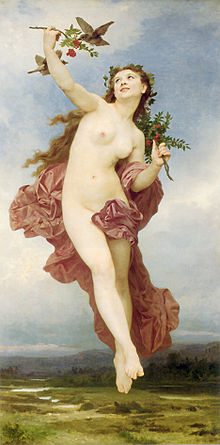死亡 (神)
外观
| 死亡(Dies) | |
|---|---|
| 日的拟人化 | |
 《赫梅拉/死亡》(1881),作者:威廉·阿道夫·布格罗 | |
| 性别 | 女 |
| 个人信息 | |
| 配偶 | 埃忒耳、凯路斯 |
| 子女 | 特鲁斯、凯路斯、海洋 |
| 父母 | 混乱和忧郁(Caligine) |
| 手足 | Nox(夜之女神)、厄瑞玻斯、和埃忒耳 |
| 对应希腊神话的 | 赫墨拉 |
死亡 (神)(Dies,/ˈdaɪ.iːz/)是罗马神话中[1](拉丁语“diēs” “day”)戴(day)的化身。她是混乱和忧郁,对应于希腊女神赫梅拉。 .
家庭
[编辑]根据罗马神话学家希吉努斯的说法,混乱和忧郁是黑夜(Nox)、死亡(Dies),厄瑞玻斯(黑暗)和埃忒耳的父母[2]。西塞罗说埃忒耳和迪斯是凯路斯(天空)的父母[3]。同时,希吉努斯说,除了凯洛斯之外,埃忒耳和迪斯也是泰拉(Terra,地球)和海洋(Mare)[4]。西塞罗还说,迪斯和凯路斯是墨丘利,对应于罗马的荷米斯[5]。
名称
[编辑]拉丁语名词"diēs"基于原始意大利语受格的单数"*dijēm",其本身源于原始印欧语的词根"*dyeu-",表示"白天的天空"或"白天的亮度"(与夜晚的黑暗形成对比)。[6][7]对应的原始的印欧神是"*帝乌斯"。
相关条目
[编辑]注解
[编辑]参考资料
[编辑]- Cicero, Marcus Tullius, De Natura Deorum in Cicero: On the Nature of the Gods. Academics, translated by H. Rackham, Loeb Classical Library No. 268, Cambridge, Massachusetts, Harvard University Press, first published 1933, revised 1951. ISBN 978-0-674-99296-2. Online version at Harvard University Press. Internet Archive.
- Hyginus, Gaius Julius, Fabulae in Apollodorus' Library and Hyginus' Fabulae: Two Handbooks of Greek Mythology, Translated, with Introductions by R. Scott Smith and Stephen M. Trzaskoma, Hackett Publishing Company, 2007. ISBN 978-0-87220-821-6.
- de Vaan, Michiel. Etymological Dictionary of Latin and the other Italic Languages. Brill. 2008 [2023-04-01]. ISBN 9789004167971. (原始内容存档于2023-01-19) (英语).
- West, Martin L. Indo-European Poetry and Myth. Oxford University Press. 2007. ISBN 978-0-19-928075-9.
